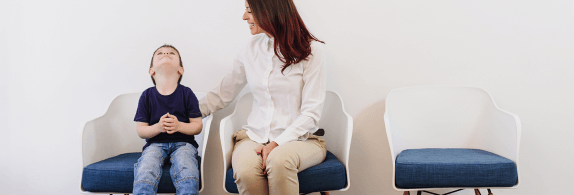Does your practice fit-out create a great first impression?
Cold and uninviting, or warm and relaxing? When a patient walks into your practice, your fit-out can shape their first impressions and determine whether they’re likely to return or not.
First impressions are just as important in healthcare as any other industry – and with some patients feeling anxious about their appointment, it’s vital to create a welcoming atmosphere that sets a positive tone for the rest of their experience.
A well-designed fit-out can help to increase patient comfort, reduce stress and anxiety, and encourage patients to have a positive association with your practice – particularly important when your patients are young children with parents who are keen to create a positive association between them and their healthcare appointments.
While practical considerations such as infection control are critical, designing your practice fit-out based on clinical efficiency alone won’t encourage patients to return or recommend your practice to others. Clean and sterile is important, but you can still achieve this alongside good interior design and a functional layout and flow.
If you’re starting a new practice, and you have the budget, there are a number of professional fit-out companies and designers that specialise in the healthcare industry. Engaging the professionals early on in the process of designing a practice will help you create a fit-out that incorporates good design principles that maximise patient comfort.
But if you have an established practice, or a limited budget to make changes, here are some simple and cost-effective ideas for making sure your fit-out creates a great first impression with your patients.
Think like a retail store
Depending on where you’re located and the services that you offer, you might be competing with a number of similar practices to yours. So, what can help you stand out?
It might be useful to take inspiration from another competitive industry – retail – and think like a retail store when it comes to your fit-out. That means identifying what your ‘aesthetic concept’ will be that will give you a unique edge, and deciding how you want to convey this visually to a ‘customer’. As soon as they walk through the door, you want them to be drawn in and feel welcome – just like in a retail store.
This could be achieved by simply choosing a unique colour scheme for the walls, adding some stylish new furniture, including striking artwork or wallpaper, incorporating lots of natural light, or creating a homely lounge room aesthetic. Natural materials and textures are very on-trend in today’s interiors, with indoor plants, bamboo, acoustic panels and sustainable materials a simple way to achieve a modern, eco-friendly feel.
Plan ahead for optimal layout
As a patient walks in, the reception area should be the first thing they see. If it’s not visible upon entry, make sure you have clear signage to direct them to where they need to go to help reduce patient stress.
If there’s enough room in your practice, provide plenty of space between the reception area and waiting patients so that medical or payment details can be discussed privately. Your receptionist should also have clear vision of the entrance, the entire waiting area and the main passage to the consult rooms in case a patient falls ill.
Also, consider a patient’s vision from the waiting area. If they can see directly into consult rooms or hear consultations clearly, they’re not likely to feel confident that their privacy will be maintained.
While it’s important to put your patients’ comfort first, you’ll also want to make sure the layout works for your team. Does it support your team’s workflows and enhance interactivity? Are there areas when staff can have private conversations if required? Do you have pharmaceutical representatives coming in and needing space to meet?
Design with comfort in mind
Gone are the days of hard plastic chairs, cold fluorescent lighting, the smell of antiseptic, and the stack of dated magazines in the corner. The objective is to create a comfortable, inviting and medically appropriate space that works for your patients and team.
You can achieve this by incorporating different seating options that are both comfortable and stylish. A combination of upright seats, lounges and stools with modern fabrics and textures can create an inviting and comfortable environment that helps put patients at ease.
If you have plenty of natural light in your practice, you’re in luck. Natural light is an instant mood booster. Make the most of this with window coverings that allow light in even when they’re closed for privacy. Otherwise, invest in lighting that’s warm and soft. Using a combination of lighting options such as overhead and tabletop lighting can create a well-lit environment that’s more reminiscent of a stylish home than the stark, fluorescent lighting that’s traditionally associated with healthcare.
Depending on the type of practice you run, soft music in the background in the waiting area can help create a relaxing atmosphere, as well as provide extra privacy for sensitive conversations. And if space permits include a refreshment area for patients to help themselves to water, tea and coffee.
Colour choice can affect mood
Research into ‘colour psychology’ shows that there is a direct correlation between wall colour and a person’s emotions. One of the more recent Australian studies involved a team of neuroscientists and psychologists assessing how colours in real environments affected people’s moods.
The study determined that certain colours can make people feel calm and relaxed, or happy and excited. The wrong colour scheme, however, can lead to feelings of boredom, sadness, or irritation. Interestingly, the study showed that light blues and greens, traditionally regarded as serene colours, did not prove calming in a clinical environment. Instead, soft pastels, greys, and neutrals are a safer bet when choosing colours for large areas.
If you want to add some stronger colours to coordinate with your brand, or simply because you prefer them, then use these colours more sparingly in smaller areas, such as on feature walls, or through your furniture or artwork.
Include ‘happy cues’ for a family-friendly practice
Is a large proportion of your patient base young children? If so, it might be a good idea to consider them when designing your practice fit-out. You want to create positive associations between children and healthcare appointments from a young age, so cater to this by providing enough things to keep them visually engaged in the waiting room. This could take the form of interesting wallpaper, bright, happy colours, and something family-friendly on the TV screen.
While having a kids’ play area isn’t a new concept in healthcare, it’s a space that has come a long way in modern medical practices. If your budget allows for it, consider including iPads with appropriate games, wallpaper that can be drawn on, Lego kits, and fun, comfortable seating.
These days, the modern practice fit-out takes inspiration from stylish homes. While it can be costly to achieve this with a professional designer, you can also create a warm and inviting atmosphere just as easily with a few simple changes. And by focusing on creating a great first impression with your patients, not only will they be happy to return, but they’ll also be more likely to recommend your practice to others.










